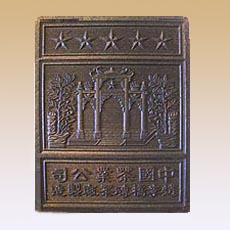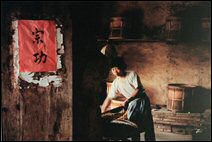
 Until the 13th century, tea was grated from bricks of pressed tea leaves made in molds—which were also used as currency in Central Asia, China, Mongolia, Siberia, Tibet (in Siberia up until World War II!). Photo courtesy Wikimedia Commons. Until the 13th century, tea was grated from bricks of pressed tea leaves made in molds—which were also used as currency in Central Asia, China, Mongolia, Siberia, Tibet (in Siberia up until World War II!). Photo courtesy Wikimedia Commons.
August 2005
Updated January 2010
|
 |
The History of Tea
Page 3: The Modern Steeping
Custom Emerges; Tea Entices The West
This is Part 3 of an 8-page article. Click the black links below to view the other pages.
The Modern Tea Steeping Custom Emerges
Not until the Ming Dynasty (1368 to 1644) was tea prepared as it is today, by steeping leaves in water. Instead of compressing tea leaves into bricks, the leaves were dried, rolled and then heated in iron woks to dry. The dried leaves were steeped in hot water. The Chinese government further established a hold on tea trade by opening a Bureau of Tea and Horses, regulating interactions on the frontier, where people traded tea for horses. From 1644 to 1911, the Qing dynasty ruled China and eventually abolished duties on tea—a testament to how essential tea had become to everyday life and the economy.

Processing tea. Photo courtesy MightyLeaf.com.
|
|
In the 17th century, a Chinese monk traveling in Japan brought the new rolled form of tea that had replaced powdered tea in China. In the 18th century, a tea merchant in Uji, Kyoto, Nagatani Soen, invented a new Japanese method of steaming, drying and rolling green tea. This tea and style of processing became known as sencha. The custom of drinking sencha tea daily prevails today. |
Tea Entices The West
Although Europeans did not see tea until the 17th century, it appeared earlier elsewhere in the West. Around the 9th century, references in Arab trade documents refer to the process of boiling bitter tea leaves. But it took many more centuries for tea to get to the Continent.
- Marco Polo (1254 to 1324) never specifically mentioned tea in his travel writings about the East. Scholars conjecture that the first Europeans to encounter tea were likely Jesuits living in Beijing who attended the court of the last Ming Emperors.
- The first western reference to tea was in a 1559 volume of travel literature entitled Voyages and Travels, compiled by Giambattaista Ramusio. In it, tea is described as a hot drink with medicinal qualities. In the 1560s, Father Gasper da Cruz mentions tea in a letter home to Portugal from China, and Father Louis Almeda does the same in a letter sent from Japan to Italy.
In spite of such early reports of tea, the product itself was did not arrive in Europe until 1610. Russia discovered tea in 1618 after the Czar received a gift of it from the Ming emperor, although some reports have it arriving earlier via camel caravans that came from China, traveling part of the way on the famous Silk Road.
Tea was not seriously traded until Dutch merchants got involved. In 1610, the first shipments of Japanese and Chinese tea arrived in Europe via ships charted by the Dutch East India Company. The popularity of tea spread to major cities, including Amsterdam, London and Paris. However, its high price limited consumption to Europe’s royal classes and aristocrats. Tea drinking, a novelty at the time, allowed the wealthy to partake of a bit of Eastern adventure during the age of exploration and discovery. Served primarily to men, it was first called cha, from the Cantonese word for tea. The name changed later to tay, or tee, when the British trading post moved from Canton to Amoy, where the word for tea is t’e.
Continue To Page 4: The British East India Company & Tea Plantations In India
Return To Article Index At The Top Of The Page

|



